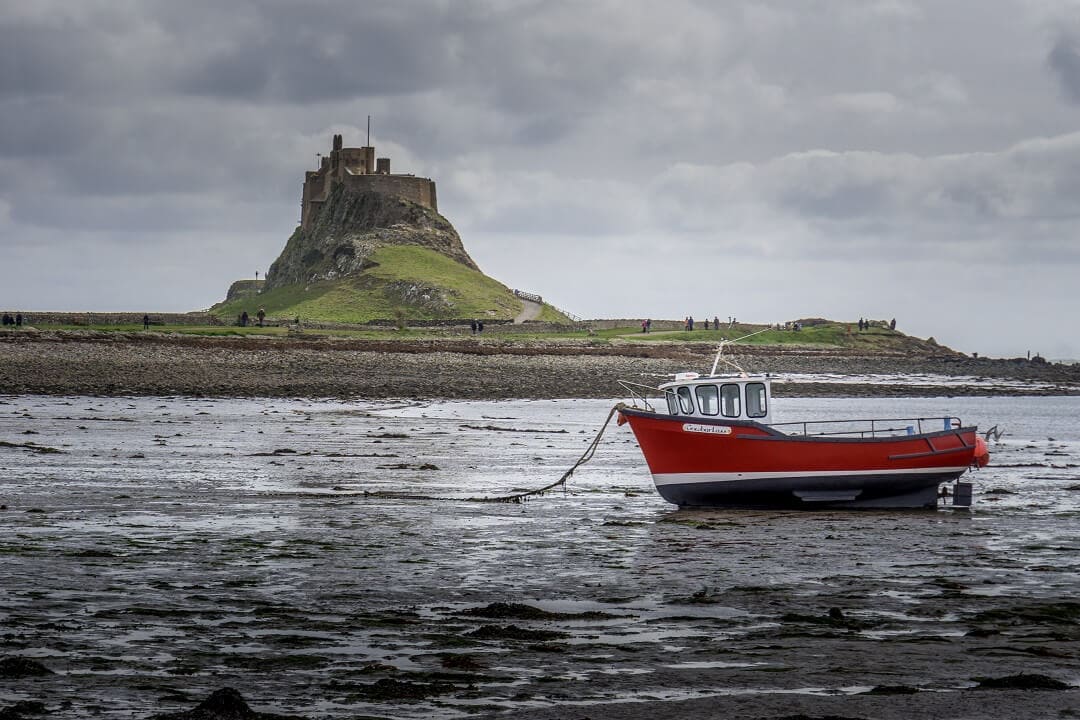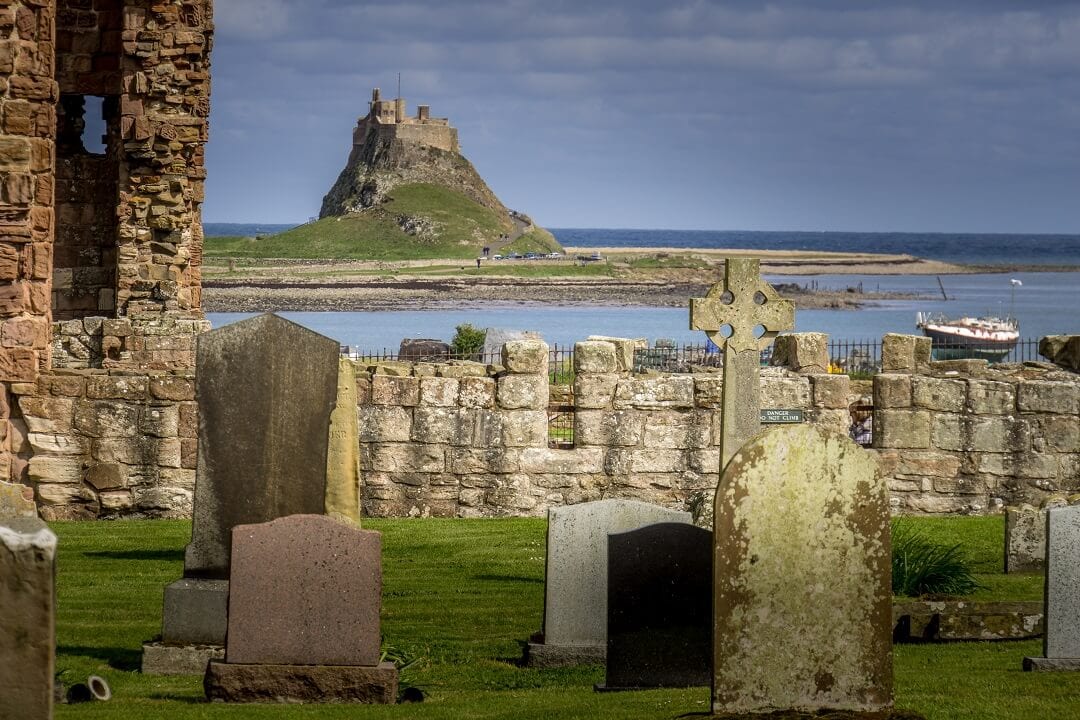Holy Island is like no other place I have visited. It’s just off the coast of England, but it’s only accessible during the low tide. The nature seems untouched, yet a monastery was founded on the island back in the 7th-century. Around 200 people still live on Holy Island today.
It’s an intriguing place, but is it worth visiting? How do you even get to Holy Island? Let me share more about this hidden gem and the best things to do on Holy Island. You won’t want to leave. Be sure to mind the tide tides or you could run into issues.
Note: This post contains affiliate links. Please see disclosure for more information.
Contents
What is Holy Island?
Officially known as the Holy Island of Lindisfarne, Holy Island (also called Lindisfarne) is a tidal island off the northeast coast of England. It’s history dates back to the 7th century and it played an important role in bringing the Christian gospel to England.

This island is only 3 miles wide and 1 1⁄2 long, comprising approximately 1,000 acres at high tide. The nearest point of Holy Island is about 1 mile from the mainland. During low tide it is accessible by car or foot, but the routes are covered with water at high tides.
Things to Do on Holy Island
For a small island, there is actually a lot to see. When you visit, I think it is important to spend some time learning about the island’s history, but be sure to also enjoy the natural beauty!
#1 Discover Lindisfarne Priory
In 635, Oswald, King of Northumbria, summoned Irish monk Aidan from Iona to be bishop of his kingdom and granted him Lindisfarne for his monastery. Aidan was eventually succeeded by perhaps the ‘greatest’ of all the Northumbrian saints, Cuthbert. In 793, the monks fled after a violent Viking attack. The ruins you see today are from the early 12th century.
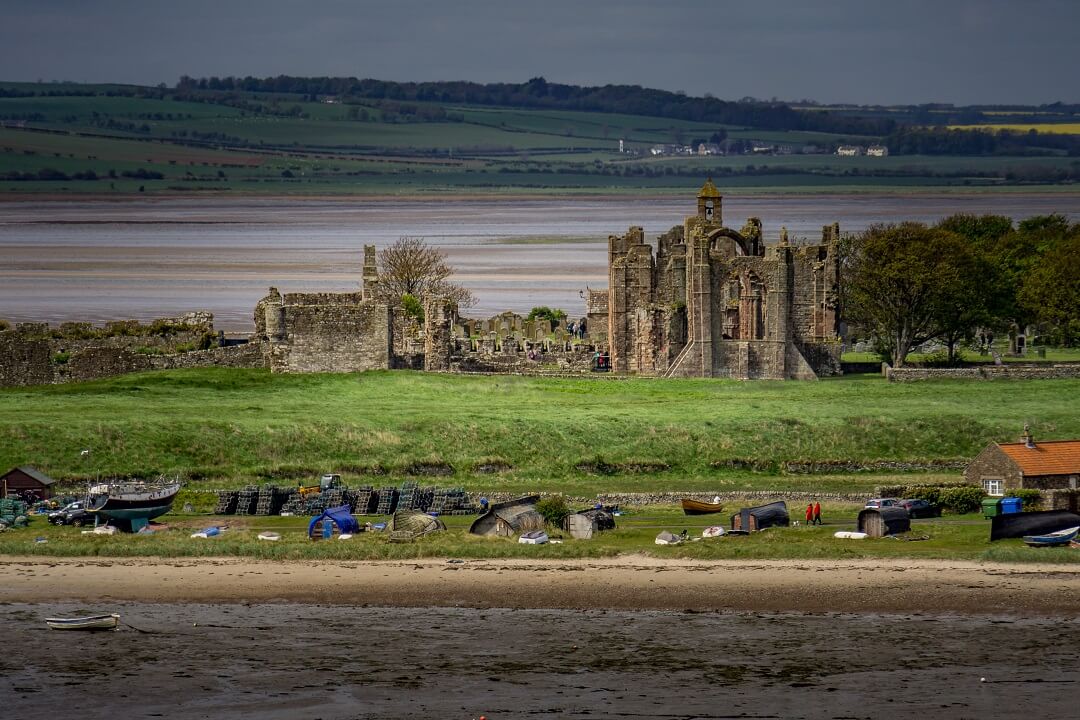
Start by going to the visitor’s center which has a small museum that tells more about the history of the site including the story of St Cuthbert, the brutal Viking attack in 793, and the 8th-century manuscript: the Lindisfarne Gospels. The original is housed in the British Library as it is one of the finest works in the unique style of Hiberno-Saxon or Insular art, combining Mediterranean, Anglo-Saxon, and Celtic elements.
The visitor’s center also has a small gift shop.
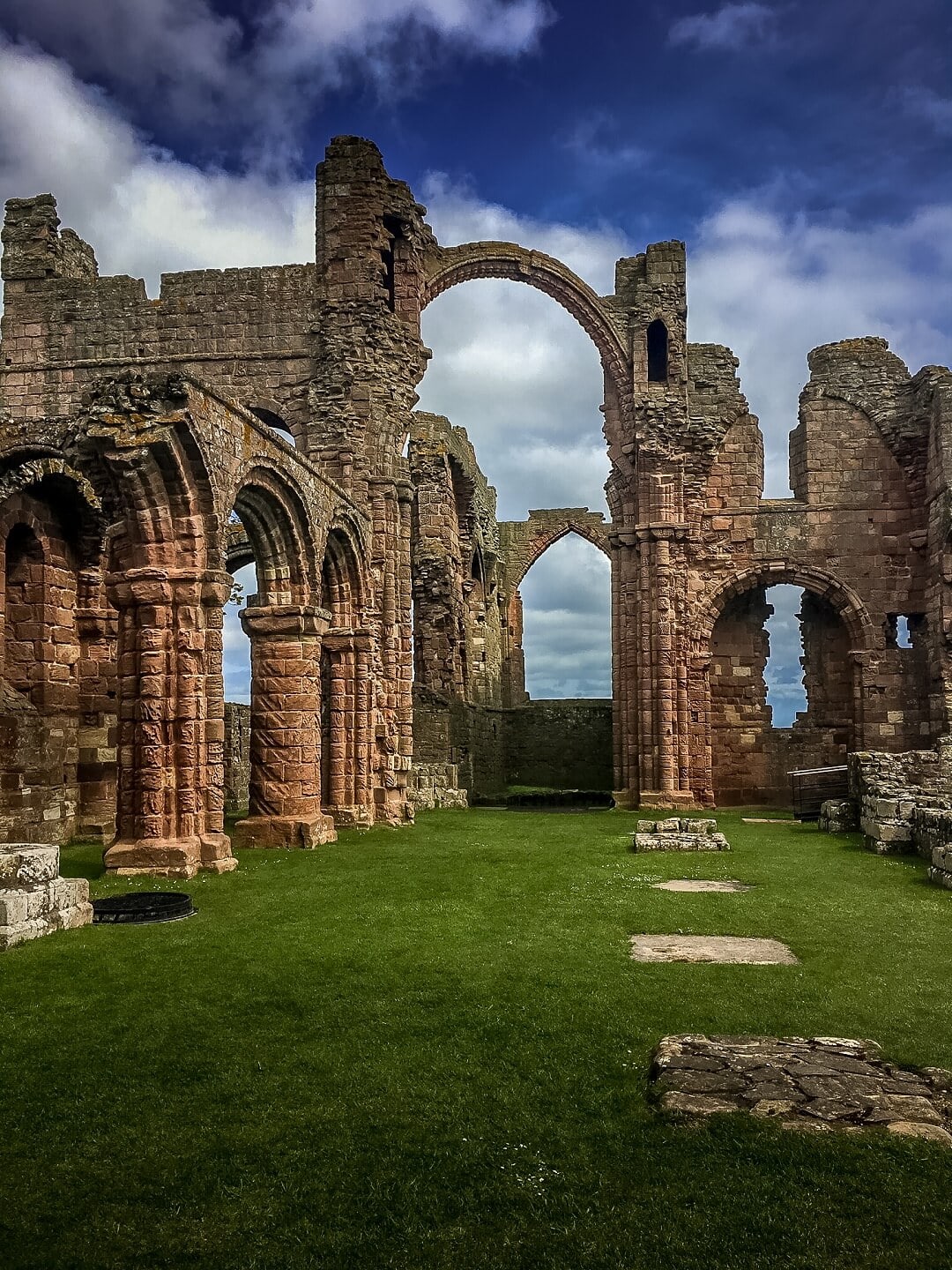
Then, go and explore the Priory. As soon as you enter, you will see the ‘Rainbow Arch’, one of Lindisfarne Priory’s most dramatic features. The ruins were much bigger than I expected and it was exciting to explore all the nooks and crannies.
I found a few spots where wildflowers were growing which made for lovely photos. Also, from the Priory, there are some framed views of the castle.
Lindisfarne Priory is run by English Heritage, so it’s one of over 400 attractions members can visit for free. Get more information about joining English Heritage here. Travelers from outside England might be interested in the visitor pass.
Opening hours for the Priory will vary based on the tides. Get details on admission prices and operating hours here.
#2 Peek Inside St. Mary’s Church
Take a few minutes to step inside St Mary’s Church located right next to the Priory. It dates from between 1180 and 1300. Experts are not sure if it was one of the churches of the original monastery or it was built later by the Christianised Vikings.

The thing that stands out is the dramatic wooden sculpture that depicts the monks of Lindisfarne carrying the body of St. Cuthbert around Northumbria. Finally, after over a hundred years, Durham Cathedral was built, specifically to house his coffin.
Note: St. Cuthbert is still buried in Durham. The city and the cathedral are well worth visiting. It’s about a 1 ½ hour drive from Holy Island.

#3 Explore Lindisfarne Castle
Lindisfarne Castle looks like something out of a fairy tale perched high atop a steep hill a short walk from the town.
When it was first finished in 1570, it was just a fort for soldiers from the larger force based at nearby Berwick. After the death of Queen Elizabeth I and the Union of the Crowns in 1603, the threat from the north decreased and the Castle lost its strategic importance.
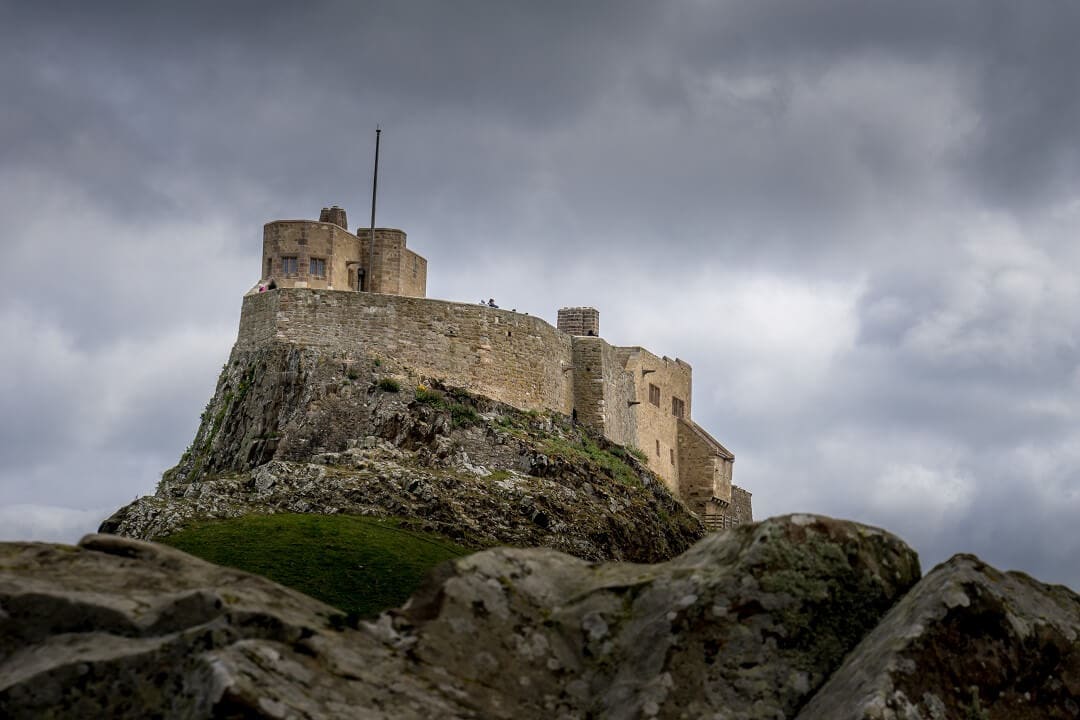
Unfortunately, over time the Lindisfarne Castle fell into disrepair. Luckily in 1901, Edward Hudson, the founder of Country Life magazine, purchased the Castle and converted it into an Edwardian country house. In 1921 he sold Lindisfarne Castle and then in 1944 it was given to the National Trust. The castle was opened to the public in 1970.
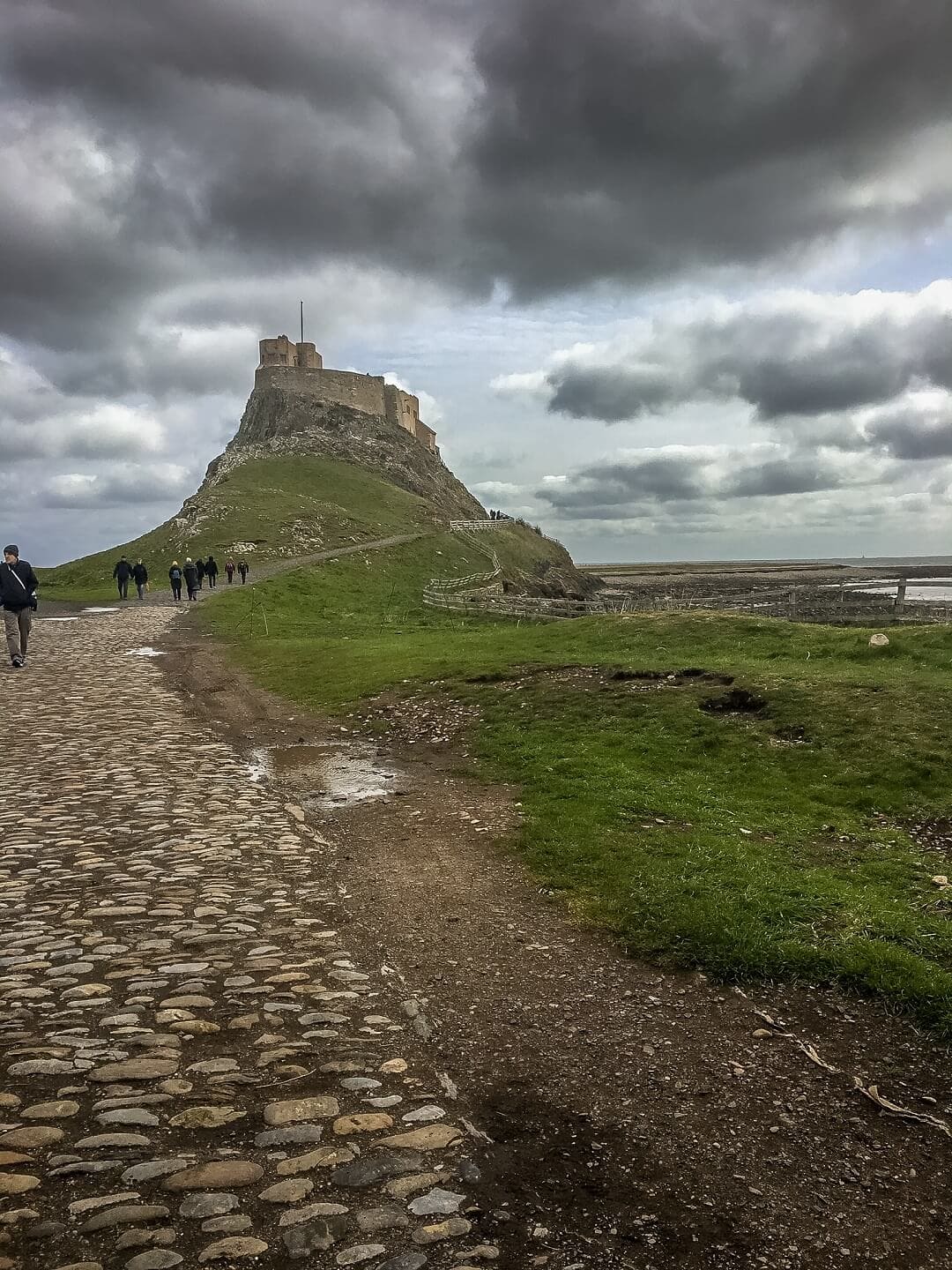
The views from the castle are spectacular, but there is not much to see inside the castle. Instead of the lavish furnishings, you might expect to see, the rooms are mostly bare with a few small exhibits. The furniture was taken away during a major renovation in 2016-2018 and has not yet been returned.
They did have a talk in the kitchen while we were there but they had too many people in the small room so we couldn’t join.

Lindisfarne Castle is a National Trust property so if you are a member, like us, it is free to visit, otherwise, I am not sure it is worth going inside. I would just walk up to the castle and admire the views. Click here to learn more about the benefits of National Trust membership. Overseas visitors may be interested in the National Trust touring pass.
Opening hours for the castle will vary based on the tides. Confirm the current hours and admission prices here.
#4 Relax in the Gertrude Jekyll Garden
In addition to remodeling Lindisfarne Castle, Edward Hudson also created a walled garden where the Castle’s vegetable plot used to be. In 2002, the National Trust used the original planting plans to bring the garden back to life and now they continue to manage the garden along with volunteers.

The best time to visit the garden is during the summer as it is stripped for the winter and replanted in spring. Take a few moments to relax on the bench and take in the view of the castle and its surroundings. It feels almost timeless.
There is no charge to visit the garden. It stays unlocked, so you can see it at your leisure, without visiting the castle itself.
#5 Taste Lindisfarne Mead
Lindisfarne Mead is a unique alcoholic fortified wine manufactured by St.Aidan’s Winery on Holy Island from fermented white grapes, honey, herbs, and the pure natural water from the island’s artesian well.
You can taste it for free at the shop in the Holy Island village. They also have an interesting selection of other beverages and snacks for sale too.

For centuries, mead has been considered an aphrodisiac and some even call it the “nectar of the gods”, so it’s definitely worth trying. I enjoyed the mead although it was a bit sweet. It is also available for sale online here.
#6 Go for a Walk
The scenery and views make Holy Island an ideal spot for a walk as long as the weather cooperates.
Of course, it could be nice to meader aimlessly and just enjoy the tranquility, but there is a structured 3-mile nature trail. Along the walk, there are numbered wooden posts to mark the best places to stop and take in the views, admire the plants, and spot the birds.
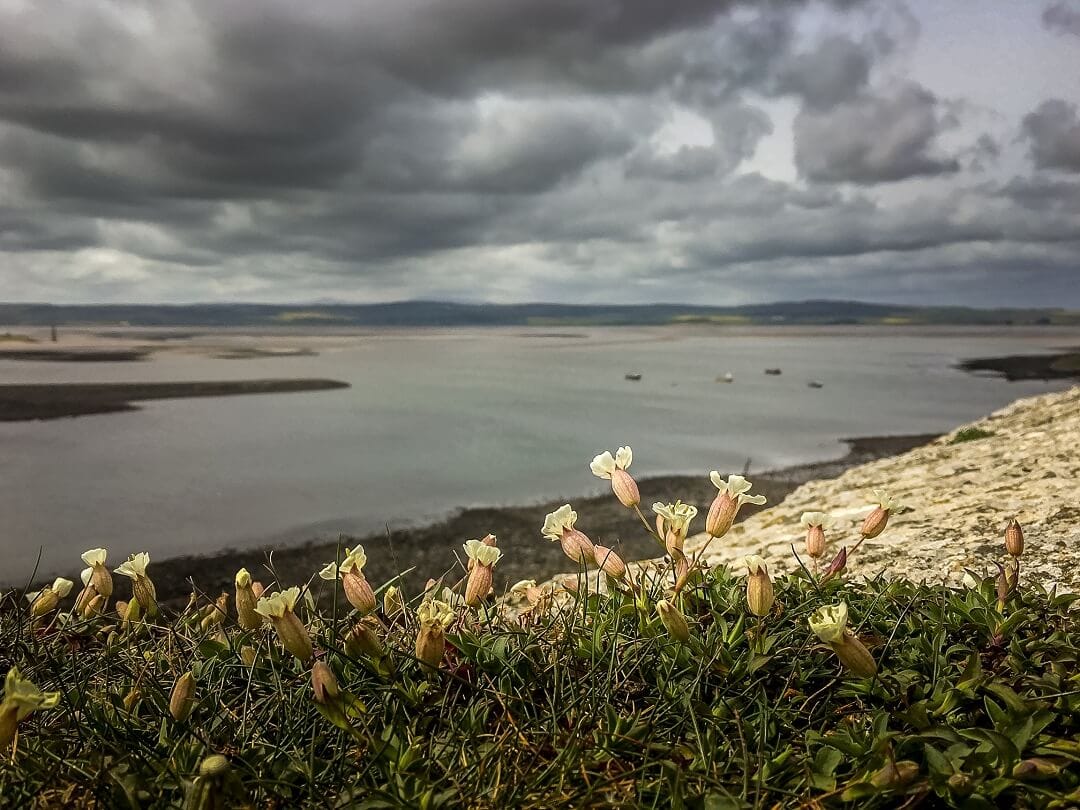
It’s important to stick to the path to avoid the pirri-pirri burs which can cling to clothing and dog fur. Please ensure the burs are not transported to other areas as the plant is very invasive. Download the map for the Lindisfarne nature trail here.
#7 Spot the Wildlife
Wildlife lovers will want to bring their binoculars. In the fall and winter months, Holy Island is filled with birds that migrate from the Arctic including light-bellied Brent geese, barnacle geese, pink-footed geese, wigeon, grey plovers, and bar-tailed godwits.
During the summer, you can see seals. At high tide, they can often be seen swimming near the Castle or Emmanuel Head. During low tide, you may be able to find them resting in the sandbanks by Guile Point which is opposite the Lookout Tower.
#8 Unwind on the Beaches
Holy Island has some beautiful quiet beaches where you can relax or go for a walk. Don’t expect to go for a swim (unless you bring a wetsuit) as the water will be cold even in the summer.
The largest beach is North Shore, but Coves Haven and Sandham Bay are also worth a visit. At high tide, you might have the whole beach to yourself.
During low tide, the mud flats go on for a very long distance into the sea. Be careful as the tide comes in very quickly and you don’t want to get stranded. That tide is nasty, deceptive, and dangerous. It’s best to do your exploring (with wellies or waterproof hiking boots) when the tide is going out.
Things to Do Near Holy Island
Whether you spend a day or longer on Holy Island, it’s a good idea to also allow yourself time to see the surrounding area. There is a lot to do nearby in Northumberland! This is not a comprehensive list by any means, it is just a few of the highlights.
Farne Islands

Sir David Attenborough calls this group of islands located a few miles off the coast near Seahouses his favorite place in the UK to see nature. The Farne Islands have a wide variety of birds including adorable puffins and seals, but there is more to these islands than just nature.
In the 7th-century, St Cuthbert lived on the islands and in the 19th-century it was home to the young Victorian heroine Grace Darling who with her father William, the keeper of Longstone Lighthouse, rescued survivors from the paddle steamer SS Forfarshire. Now, the islands have no permanent residents, but National Trust assistant rangers stay on the island during part of the year.
Several companies offer boat trips to see the islands. Alternatively, you can go diving with seals. Get more information about visiting the Farne Islands here.
Bamburgh Castle
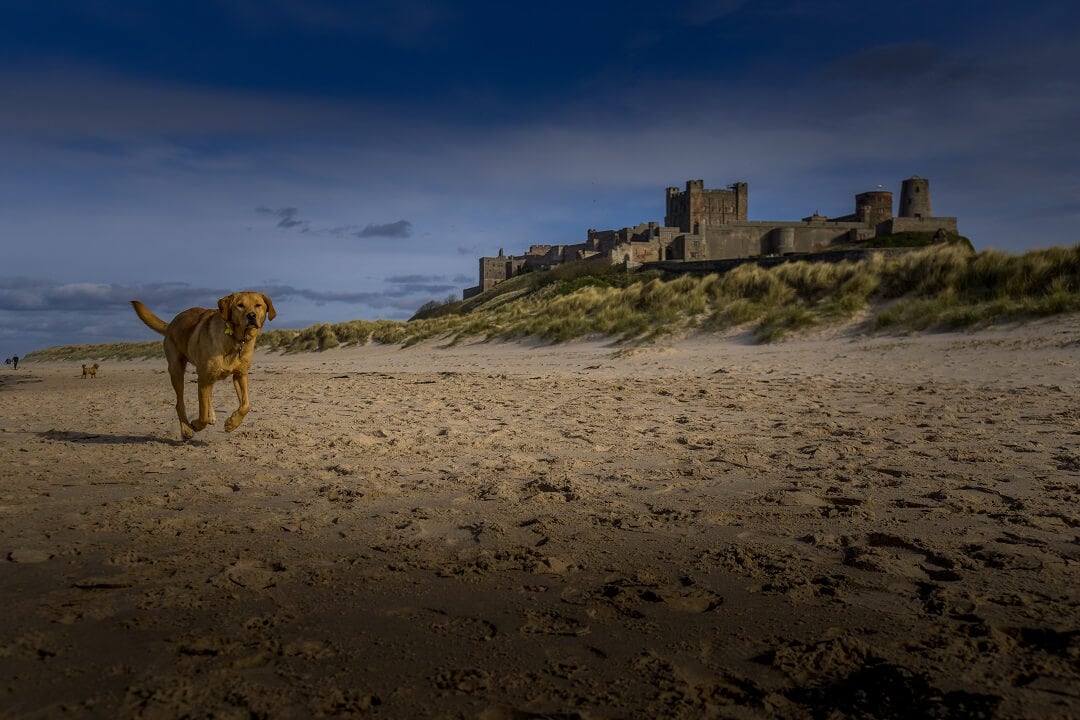
Bamburgh Castle is one of the most picturesque castles in England. It sits atop of volcanic rock so it is visible from miles away.
The site was the capital of the Anglo-Saxon Kingdom of Bernicia until it was destroyed by the Vikings in AD 993. Later the Normans built a castle on the site which formed the core for the present building. The castle started deteriorating in the 17th century due to financial difficulties, but it was restored by various owners during the 18th and 19th centuries.
It takes about 20 minutes to drive between Bamburgh Castle and Holy Island. Read more about Bamburgh Castle here.
Berwick-Upon-Tweed
Berwick-Upon-Tweed is the northernmost town in England, located at the mouth of the River Tweed. It’s a historic market town dating back to the 10th-century. Over the years, it has been captured 13 times before finally falling into English hands in 1482.
Berwick’s great Elizabethan walls were built to keep invading Scots out. These walls are not like any others I have seen. They are wide enough to fit a park on top! We enjoyed walking around the town on top of them.
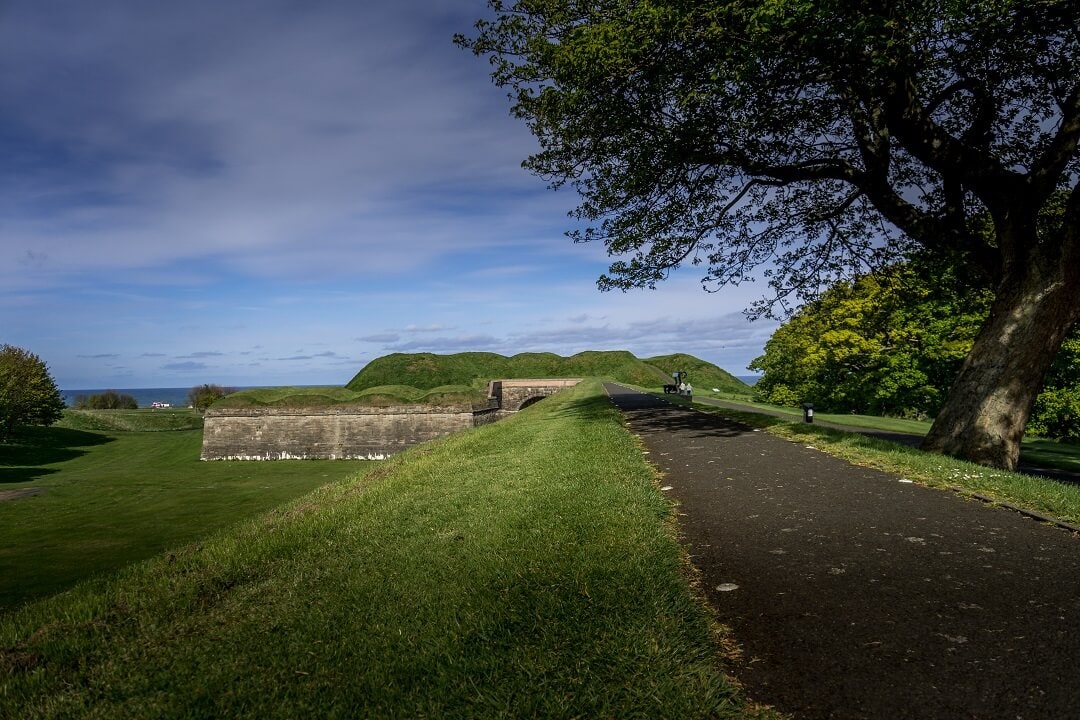
You can learn more about Berwick’s tumultuous history by visiting the museums in Berwick Barracks and The Main Guard. Inside the Berwick Town Hall, you can take a tour of the town’s old courtroom, jail lockups and notorious ‘drunk’s cell.’
Alnwick Castle and Gardens
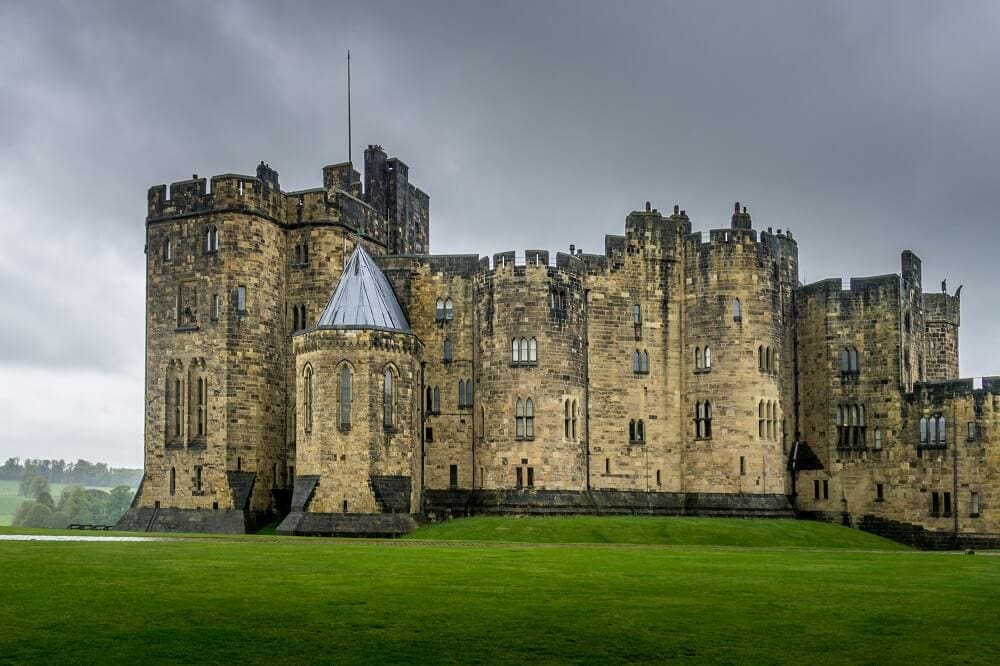
Alnwick Castle is the home of the famous Percy family and also a Harry Potter filming location.
When you visit the castle, you can see the staterooms, go on a dragon quest, visit museums, and even take a broomstick training lesson. Be sure to also allow some time to explore the Gardens where you can see the impressive water features, tour the mysterious poison garden, visit one of the largest treehouses in the world, and more.
It’s about a 30-minute drive between Alnwick Castle and Holy Island. Read more about Alnwick Castle and Gardens here.
Planning Your Visit to Holy Island
As any local will tell you, it is vital to check the tide times before planning your visit to Holy Island. There are limited times when it is safe to cross the causeway. You do not want to get swept up by the tide or stuck at the refuge tower in the middle.
There are 10 rescues on the causeway every year. The tide comes in fast and it is not possible to outrun it even in a car because it’s deeper at one end than the other. Don’t be a statistic. Your car will likely be destroyed and insurance probably won’t cover it.
In 2019, Ryan Douglas, senior maritime operations officer for HM Coastguard said, “We would strongly recommend that people do not attempt to drive their vehicles on the causeway outside of the published safe crossing times. The speed and power of an incoming tide should not be underestimated, it will cause damage to property and is a serious risk to life. Before you start your journey plan ahead, check the weather and tide times.”
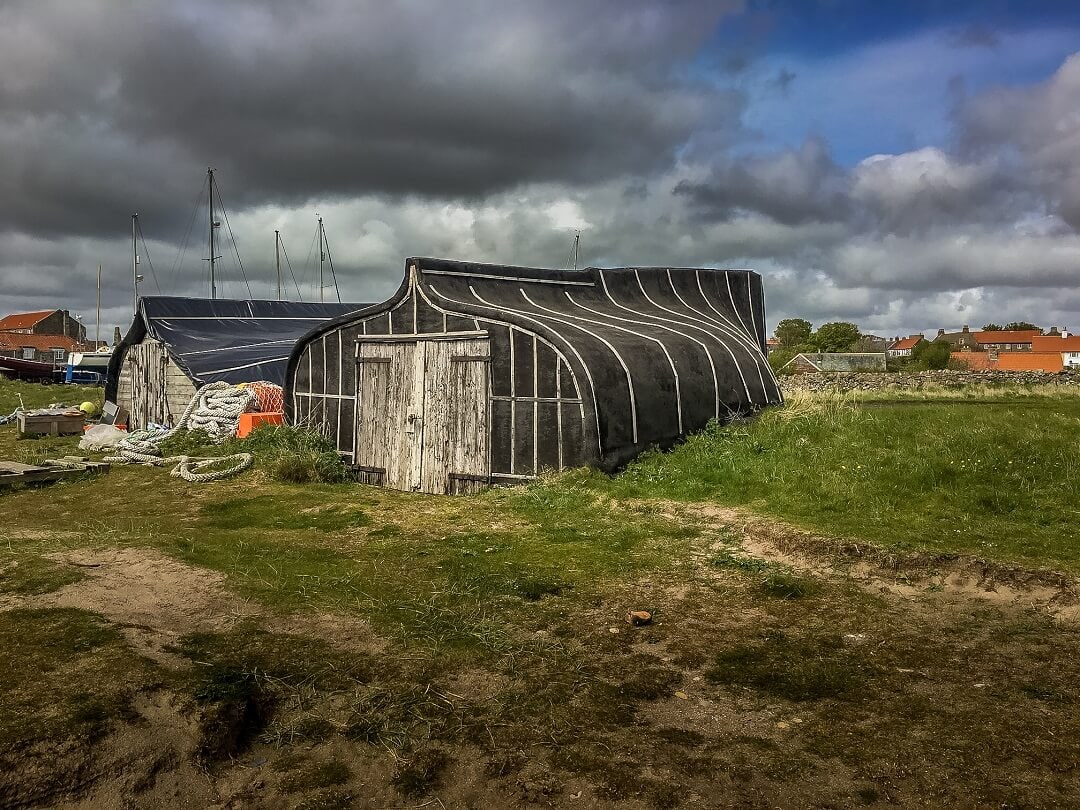
The high season for Holy Island is Easter through October. You can still visit during the off-season but some attractions will be closed.
We just spent a day on Holy Island, but if you want to relax and stay longer it’s possible. There are a few hotels, B&Bs, and holiday homes to choose from including some run by the National Trust. Get more information here.
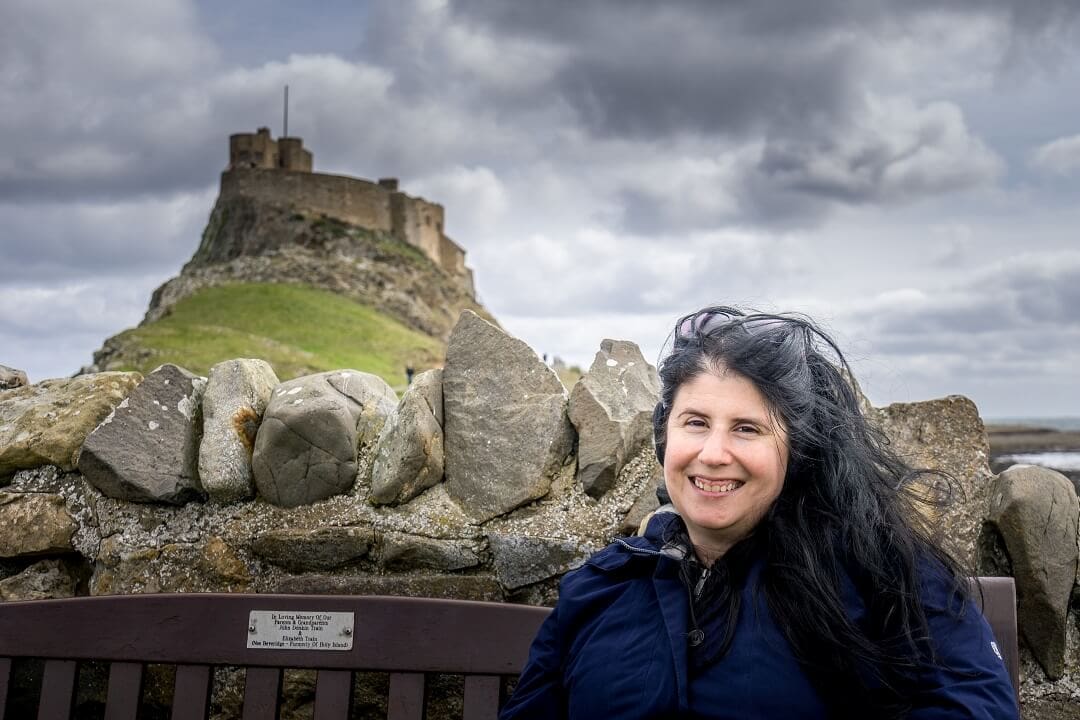
How to Get to Holy Island
We drove to Holy Island, but you can also walk, take a taxi/bus from Berwick, or travel by boat. No trains go to Holy Island. If possible, it’s best to have a car so that you can have more flexibility to explore the area.
Whichever option you choose, be sure to check the tide times and schedules as they are always changing.
Driving to Holy Island
The causeway that leads to Holy Island is not far from the A1. Approximately 8 miles south of Berwick-Upon-Tweed, you need to turn off to go east towards Beal. This road will take you to Holy Island.
Just as you arrive on the island after crossing the causeway, there is a Pay & Display parking lot. Get a ticket to park for 3-hours or all-day. From here, you can easily walk to the attractions or take the hop-on-hop-off shuttle bus if you have mobility issues. Frankly, nothing is very far away on an island this small, so you might as well walk if the weather is good.
Walking to Holy Island
Until the causeway was built in the 1950s the main route people followed to get to Holy Island was walking along the Pilgrim’s Way. The three-mile long crossing is marked out by poles in the sand and is more direct than the causeway road (used by all other traffic).
Walking to Holy Island can take about 2 hours depending on where you start walking. While it is a pretty flat walk, it is not without its dangers. You need to be careful with the tides.
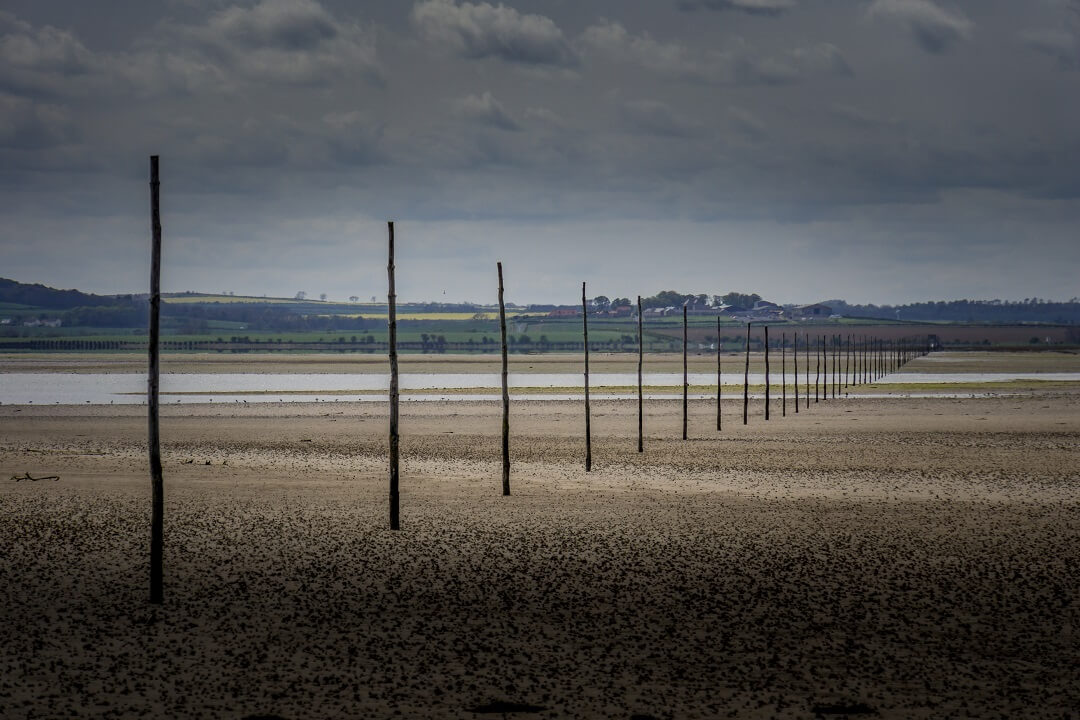
Do not attempt to walk to Holy Island at night, when the tide is rising, or during bad weather. Remember that the tide tables apply to cars. The Pilgrim’s Way will be underwater during some of this time (note: there are parts that can get flooded at any time). It is only safe to cross on foot during the middle of the safe crossing times for cars. There are refuge towers along the route but don’t put yourself in a situation where you might need to use them.
If you plan on crossing over to Holy Island on foot, do so barefoot or in waterproof footwear. The route is muddy! It’s a good idea to carry a bag with your normal footwear, sunscreen, water (to drink and use to wash the sand off), and a towel to wipe off.
Read more about walking to Holy Island here.
Getting from Berwick-Upon-Tweed to Holy Island Without a Car
From Berwick, it’s best to get a taxi to take you to Holy Island. A one-way taxi trip costs about £25-£29. It’s best to call either Woody’s, tel. +44(0)1289 547009 or 1st Cab, tel. +44(0)1289 545007 to book as online prices will be more expensive.
There was a bus service from Berwick station to Holy Island, but I don’t think it is still running as the timetable is no longer available online. You can check the Border Buses website to see if the 477 bus resumes.
Taking a Boat to Holy Island
Billy Shiel’s Boat Trips provides scheduled boat rides from Seahouses to Holy Island from May to October. On the way to Holy Island, wildlife lovers will enjoy the views as they will take you by Inner Farne and Megstone.
The boat reaches Holy Island at high tide when the island is cut off from the mainland. You get two hours ashore to explore the island. Then on the return journey, you can enjoy the beautiful coastline and views of both Lindisfarne and Bamburgh Castles.
Get more information here.
Traveling from London to Holy Island
If you are coming from London, there is a direct train from Kings Cross to Berwick-Upon-Tweed, which takes about 4 hours. From Berwick, take a taxi or possibly bus to get to Holy Island.
Traveling from Edinburgh to Holy Island
If you are coming from Edinburgh, there is a direct train from Waverley Station to Berwick-Upon-Tweed which takes about 45 minutes. Alternatively, there is a bus from the Edinburgh bus station that takes about 1 ½ hours. From Berwick, take a taxi or possibly bus to get to Holy Island.
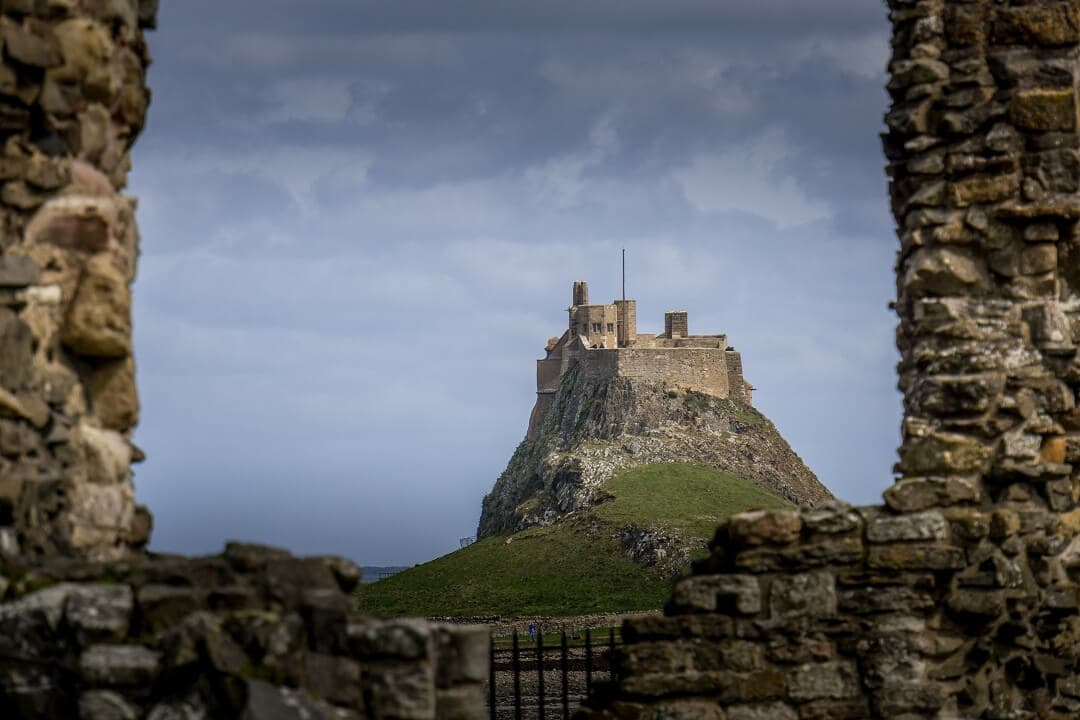
Is Visiting Holy Island Worth It?
Holy Island is one of the places on the Northumberland Coast in England that you must see. It has an interesting history and beautiful scenery. There is something magical about it. Just be sure to pay attention to the tide times when you plan to visit.
Have you been to Holy Island? If you are ready to plan your trip, be sure to check out my vacation planning checklist.
-Anisa
Pin For Later
Expert Tips for Your Visit to the Holy Island of Lindisfarne
- Check the tide times. Don’t try to go to Holy Island without knowing when it is safe to cross.
- Take time to learn about the history and also explore the natural beauty of Holy Island.
- It is free to visit the Priory if you are an English Heritage member and it is free to visit the Castle if you are a National Trust member.
Disclosure: This post contains affiliate links. This means we will receive a small commission for some purchases made using links in our blog with no additional cost to you. Please be assured we would not promote any product unless we believe that our readers will also benefit. The commission does not influence the editorial content of this site.
Two Traveling Texans is a participant in the Amazon Services LLC Associates Program, an affiliate advertising program designed to provide a means for sites to earn advertising fees by advertising and linking to amazon.com, amazon.co.uk, amazon.ca. Amazon and the Amazon logo are trademarks of Amazon.com, Inc. or its affiliates.
Last Updated on December 29, 2021

